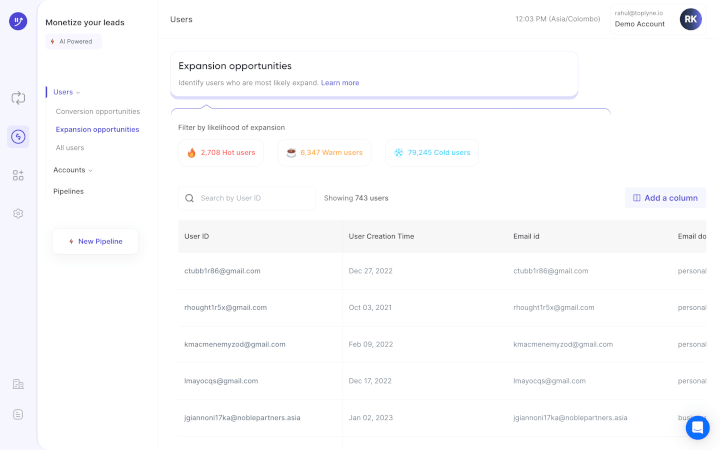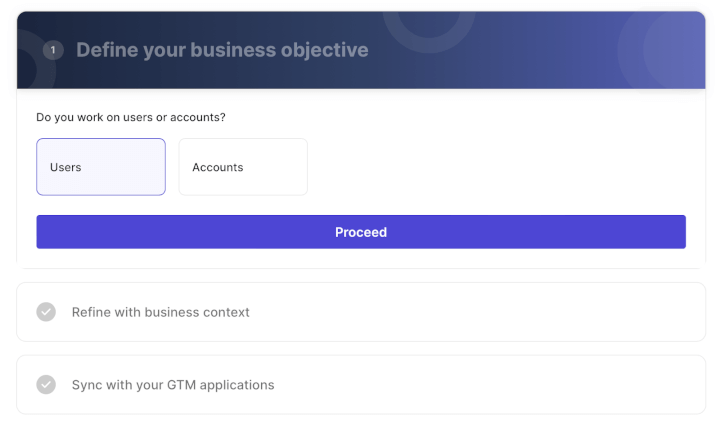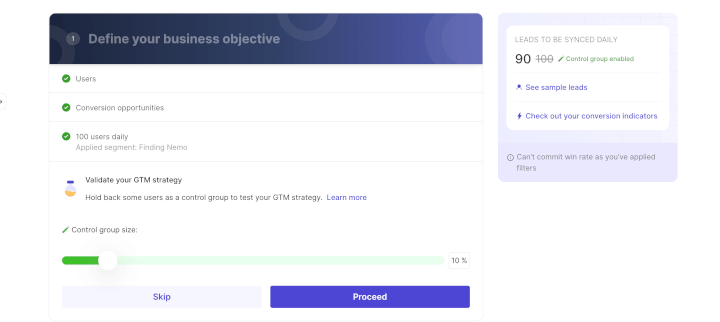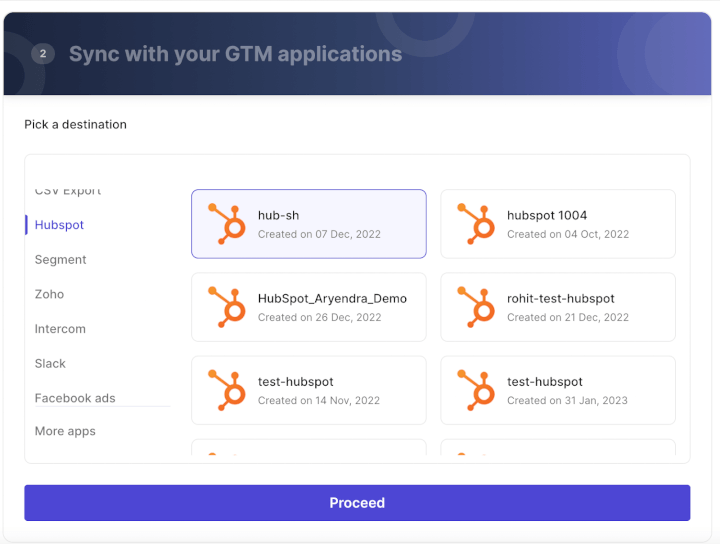5 Key Lead Qualification Stages (+ A Smarter Way to Qualify Leads)

What’s the most challenging part of the SaaS sales process?
For many, it’s finding high-quality leads with the potential to convert.
Why?
Some marketers don’t know which lead qualification stage their lead falls into or are unclear about the concept of lead qualification in general.

If you don’t want to fall into this bracket, this post is for you.
In this article, we’ll clearly define what lead qualification means, the different lead qualification stages you need to be aware of, their benefits, and the key strategies for finding high-quality leads.
And we take it a step further!
We’ll tell you the right kind of leads you should be chasing after and an intuitive tool that can fast-track this job for you.
Let’s take the lead on lead qualification!
What Is Lead Qualification?
Lead qualification comes after lead generation (sourcing interested customers) in a sales cycle.
It is the process of identifying the likelihood of a prospect in your sales pipeline making a final purchase.
Here’s the deal:
Every month your marketing team may gather hundreds of leads.
Firstly, kudos!
This means the time and money spent on lead generation is paying off.

But no matter how fantastic your lead generation or marketing efforts were, only a few of these incoming leads would convert and pass through the sales funnel.
Now, that’s ok because that’s where the lead qualification process comes to play. Using specific parameters, you can qualify leads into different stages and target them with the right marketing strategy for higher conversions.
Lead Lifecycle Stages
Understanding the lead lifecycle stages is essential for any SaaS business looking to improve its lead management and increase conversion rates.
Typically, the lifecycle of a lead in SaaS involves several key stages: lead generation, lead nurturing, lead qualification, opportunity creation, and deal closure. Each stage requires specific strategies and tools to effectively move leads towards a closed won. For instance, during the lead nurturing stage, personalized email campaigns and targeted content can be highly effective.
As leads progress to the qualification stage, more direct engagement through demos or detailed discussions about product capabilities becomes crucial. Recognizing and optimizing each of these stages within the lead lifecycle allows for a more targeted approach, reducing time and resources spent on unqualified leads and increasing the chances of converting promising leads into loyal customers.
Five Key Stages of Lead Qualification
Based on where your lead is in the sales funnel, you can categorize your prospects under five stages.
Stage 1: Information Qualified Leads
Consider these leads in the topmost part of your sales funnel — with virtually no filter.
Information qualified leads are internet users seeking solutions for their problems.
These leads provide you with their details in exchange for some kind of information. For example, they could share their names and email ids when filling out a form 📋 or signing up for a newsletter 📰.
At this point, they are unaware of your business and what you could offer them.
They are only thinking about...

Stage 2: In-Profile Leads
In-profile leads still haven’t expressed any interest in your product or service.
But now you can narrow them down if you know what your qualified lead or a potential customer should look like. This increases their likelihood of buying your product or service.
Consider it like defining your ideal partner. 💑
You know what qualities you seek in them to have a long and healthy relationship.
Same way, the information qualified leads should fit your ideal customer profile, making them the perfect match for your company.
For example, if you offer a CRM tool, your ideal customers might be small or medium-sized businesses looking to streamline operations and boost productivity. Likewise, if you offer a beginner-friendly video editing tool, your ideal customers could be freelance content creators like vloggers or Youtubers.🎥
What’s important to note is that most leads at this stage are qualified but not ready to buy yet. This takes us to the next stage of the lead qualification process.
Stage 3: Marketing Qualified Leads (MQLs)
When an in-profile lead expresses some form of interest in your product or service or shows early buying behavior, you can identify them as a marketing qualified lead.
Remember: These leads are pre-qualified based on your ideal customer profile. But now, they have interacted with your marketing material or content offers and shown a clear interest in your product or service.
This interest could be in the form of:
- Multiple website visits
- Downloading a white paper
- Attending a webinar
- Requesting a product demo.
Or, you can have these leads try out your product and use Toplyne to qualify them more accurately as product qualified leads.
Coming back to MQLs, at this point, these leads are aware of their own challenges and what solution your business could offer them. They can be handed over to the sales team for further nurturing.
But guess what?
Not all marketing qualified leads are ready to enter the sales pipeline.
So, how do you identify a worthy marketing qualified lead?

Nope. You don’t need to be a detective to know this.
All you need is a lead scoring system for inbound lead qualification, i.e., the leads coming in through the marketing content.
Lead scoring is a way of qualifying sales leads by assigning a point value to each lead action. The total of these actions gives you a lead score. More on this later!
Naturally, a lead with a higher score is more likely to convert to a paying customer than a low scoring one. The marketing team then passes on the high-scoring leads to the next lead qualification stage.
Stage 4: Sales Accepted Lead (SAL)
There are specific lead characteristics that your lead score might not be able to capture. That’s why marketing qualified leads are passed on to the sales team as a Sales Accepted Lead (SAL).
At the SAL stage, your sales team will feed these leads into a lead qualification framework (we’ll cover these shortly) and ask qualifying questions related to budget, authority, sense of urgency, and other factors.
A sales representative may ask these qualifying questions via phone, emails, meetings, or other modes of communication.
Based on their answers, the sales rep will tag this lead as a qualified or unqualified lead.
What happens to the unqualified lead?
These leads go through a nurturing process and are warmed up to the product to make a purchase later down the line.
On the other hand, the qualifying leads move forward in the sales cycle or sales pipeline and become sales qualified leads.
Stage 5: Sales Qualified Leads (SQLs)
A qualified prospect with a high probability of converting reaches the final sales lead qualification stage.
A sales qualified lead typically has:
- A requirement for your product.
- Shown an interest in your product.
- Been assessed by your marketing team and deemed the right fit.
- The budget to buy your product.
- The authority to make the buying decision.
If the lead ticks off every requirement on the lead qualification checklist, it’s the job of a sales representative to nurture a sales lead until they strike a deal.
Remember: Sales qualified leads require timely follow-ups and nudges from your sales team to make the final purchase decision.
Now you may wonder — is sales lead qualification really necessary?
Why not simply pass every lead through the sales process and improve the odds?
Lead Lifecycle Management
Lead lifecycle management is a crucial component of a robust sales strategy, particularly in the SaaS industry where understanding the journey of a lead from initial contact to final conversion can significantly enhance the effectiveness of sales efforts.
This management process involves tracking and nurturing leads through various stages of their lifecycle, ensuring that they receive the appropriate marketing messages and sales pitches at the right time.
Implementing a systematic approach to lead lifecycle management helps businesses optimize their marketing strategies, align sales and marketing teams, and ultimately, improve conversion rates.
Tools like CRM systems are often integral to this process, as they provide the necessary data and analytics to monitor lead progression and engagement effectively.
Let’s check out why step-by-step lead qualification is a crucial leg of your sales process.
Four Proven Benefits of Lead Qualification
Here are some of the perks of lead qualification that SaaS leaders swear by:
- Offers more visibility: Passing each lead through the lead qualification stages gives you better visibility into promising sales opportunities. Your sales team can direct their immediate attention to quality leads to meet sales targets faster. 🎯

- Saves time and resources: While passing a lead through five stages may look daunting, it actually helps you save time and effort. Your team can only focus on quality leads with better chances of converting, so you use your resources optimally and increase your ROI.
- More personalized approach: Since your team will know which leads to go after and their key characteristics, they can create a more personalized sales pitch to be more convincing.
- Better sales and marketing alignment: Clearly defining your lead qualification and lead scoring criteria can help align your marketing and sales teams on what a qualified lead should be. This will help your marketing team capture relevant leads and pass them on to the sales team for conversion.
So are there ways to make this lead qualification process even better?
Let’s find out next.
Three Surefire Ways to Find High-Quality Leads
Make your qualification process fool-proof with these crucial steps:
1. Define Your Ideal Customer Profile (ICP)
To find something, you must first know what you are looking for.

In the case of the lead qualification process, it’s your ideal customer profile.
Think of your ideal customer as a company or individual that would benefit the most from using your product or service. You can then define this company or individual in terms of industry, company size, demographics, and more.
The idea is to have an agreed-upon definition of a lead so both your sales and marketing teams know which prospect they should be actively chasing.
2. Establish a Lead Scoring System
A lead scoring system can help you determine if a lead is a high-quality lead ready for sales qualification and when is the right time to reach out to them.
It’s a crucial leg of inbound lead qualification.
Here’s how it works.
Under a lead scoring model, you assign different point values to different behaviors like:
- Visiting your website a significant number of times.
- Downloading your product’s specifications sheet.
- Consistently opening your marketing emails.
- Taking part in your free webinars.
- Requesting a free quote.
Likewise, you assign negative points to actions your ICP shouldn't take, like unsubscribing from your monthly newsletter.
In addition to these actions, you also need to assign values to demographic and firmographic characteristics like:
- Age
- Sex
- Location
- Job title
- Company size
After adding the positive scores and deducting the negative ones, you get your lead score. And if a lead achieves a desired lead qualification score, the marketing qualified lead becomes sales qualified.
Easy-peasy, right?
But remember.
The lead scoring model for every company will be different. The score you assign to each indicator will depend on company priorities, what you’re selling, and how you’re selling it.
3. Feed Leads into the Lead Qualification Framework
Your sales and marketing team has identified the ideal customer profile and knows what lead score they should be targeting.
They may think…

Well, not so soon!
During the lead qualification process, there may be cases when a lead fits the ideal profile and achieve a high score, yet they may never become your customers. *sobs*
To avoid this heartbreaking 💔situation, you need a lead qualification framework.
Here, your sales rep will ask a series of qualifying questions to ascertain whether they’re a good or poor product fit.
Here are some sample questions:
- What challenge can this product help you solve?
- What’s your budget for this project?
- What is your priority in terms of solving this problem?
- Who in your team would use this product?
- Who are the decision-makers involved in the purchase?
Based on the answers to the qualification framework, you can qualify or disqualify a lead.
There are several frameworks you could follow to assess a qualified prospect. The most commonly used lead qualification framework is BANT.
BANT qualification framework stands for:
- Budget: Does the company have the budget to purchase your product or solution?
- Authority: Is your lead the decision-maker or involved in decision-making?
- Need: Does the prospect truly need your product or service?
- Timeline: How long will the prospect take to make the purchase decision?
The other lead qualification frameworks include CHAMP, MEDDPICC, GPCTBA/C&I, ANUM, and FAIN.
Now, here’s the real kicker.
No matter how elaborate these qualification stages may be, they are still a time-consuming and old-school way of qualifying leads. Moreover, you can’t assess engagement levels solely based on these lead scoring metrics.
The solution?
Enter Product Qualified Leads.

Product Qualified Leads: The Right Kind of Leads to Go After
A product qualified lead (PQL) differs slightly from sales qualified and marketing qualified leads.
How?
A product qualified lead is a prospective customer who has derived meaningful value from your product (read: AHA moment!) by signing up for a free trial or the freemium plan.
It's a lead you capture through a “try-before-you-buy” or “product-led growth” approach.
Want to know more about product lead growth? Check out these fantastic PLG examples.
But why are these leads better than a marketing or a sales lead?
Two main reasons:
1. You only reach out to good quality leads: Instead of depending on a lead qualification checklist, you can use actual product usage data to qualify leads showing real buying intent. That means the chances of a sale are higher.
2. You engage with them at the right time: Your app usage data could reveal the right sales opportunity to engage with your potential customer, like when they hit a usage limit or use a feature excessively. This leads to shorter sales cycles.
Now comes the Big Q — How to recognize a product qualified lead?
Toplyne at the door!

Toplyne is a one-of-a-kind headless sales AI that works in the background to surface a high-intent pipeline of product qualified leads. This tool works silently in the background and within your existing sales tool.
By identifying the right leads, Toplyne helps you increase your win rate and improves your Net Revenue Retention by boosting upselling and cross-sell opportunities.
How?
Toplyne easily integrates with your existing sales stack and lets you use product usage insights from data sources like Amplitude, Mixpanel, etc., to target the right cohorts of free users.
Here’s how companies like Canva and Vercel generate sales pipeline from their self-serve funnel using Toplyne:
- Step 1/7: Create monetization playbooks to surface conversion and expansion opportunities (leads most likely to convert to paying customers, and teams most likely to grow into larger teams)

- Step 2/7: Choose the right leads to target – users (individual users) or accounts (a group of users with an organization).

- Step 3/7: Select the frequency at which you would want leads synced in your GTM apps.

- Step 4/7: Define how many leads you want by either the number of leads or your expected win rate, depending on your sales capacity and GTM strategy.

- Step 5/7: Build custom segments - Build custom segments based on And/Or logic at the deepest level of sub-properties within your product analytics.

- Step 6/7: Validate your GTM strategy - Hold back some users as a control group to test your GTM strategy.

- Step 7/7: Sync your product qualified pipeline into your GTM destinations - CRMs, sales & marketing execution tools, and customer engagement platforms.

This way, your sales team can use their existing tech stack alongside Toplyne with zero change management.

Fast-track Your Lead Qualification with Toplyne
The five stages of lead qualification covered above work well to help you focus on quality leads and close more deals. But this is the ordinary way to qualify leads.
Want to try the ‘extra-ordinary?’
Having product qualified leads is a smarter, more certain, and more effective way to qualify prospects.
And with an intuitive tool like Toplyne, you can fast-track this process at lightning speed.⚡
This headless sales AI tool can help you spot conversion and expansion opportunities quickly by working right in your sales stack.
Sign up for free to gear up your lead qualification!



.svg)









.png)